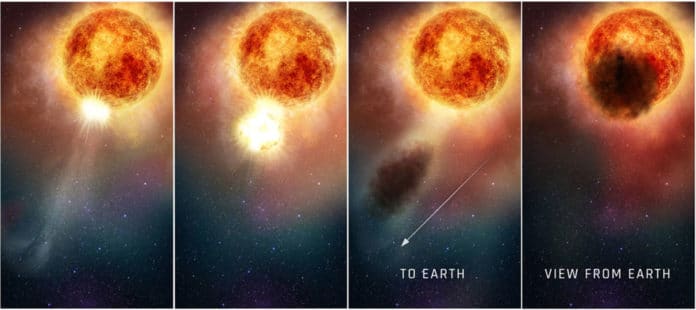Betelgeuse is a red supergiant star in the constellation Orion. It left the main sequence about one million years ago and has been a red supergiant for about 40,000 years.
Astronomers have been monitoring Betelgeuse for a long time. The photometry data from the last 25 years is the most thorough, and according to that data, the star is as dim as it’s ever been.
Betelgeuse keeps getting dimmer, and everyone is wondering what exactly that means.
The star was expected to go supernova at the end of its life, but that’s not projected to happen for tens of thousands of years. So what’s causing the dimming?
NASA‘s Hubble Space Telescope seems to found the reason. Observations by the Hubble shows that the unexpected dimming of the supergiant star Betelgeuse was most likely caused by an immense amount of hot material ejected into space, forming a dust cloud that blocked starlight coming from Betelgeuse’s surface.
The dust cloud formed when superhot plasma released from an upwelling of a large convection cell on the star’s surface passed through the hot atmosphere to the colder outer layers, where it cooled and framed dust grains. The resulting dust cloud blocked light from about a quarter of the star’s surface, starting in late 2019. By April 2020, the star came back to normal brightness.
Hubble captured signs of dense, heated material moving through the star’s atmosphere in September, October, and November 2019. Then, in December, several ground-based telescopes observed the star decreasing in brightness in its southern hemisphere.
Andrea Dupree, associate director of the Center for Astrophysics | Harvard & Smithsonian (CfA), Cambridge, Massachusetts said, “With Hubble, we see the material as it left the star’s visible surface and moved out through the atmosphere before the dust formed that caused the star to appear to dim. We could see the effect of a dense, hot region in the southeast part of the star moving outward.”
“This material was two to four times more luminous than the star’s normal brightness. And then, about a month later, the south part of Betelgeuse dimmed conspicuously as the star grew fainter. We think it is possible that a dark cloud resulted from the outflow that Hubble detected. Only Hubble gives us this evidence that led up to the dimming.”
Journal Reference:
- Andrea K. Dupree et al. Spatially Resolved Ultraviolet Spectroscopy of the Great Dimming of Betelgeuse. DOI: 10.3847/1538-4357/aba516
